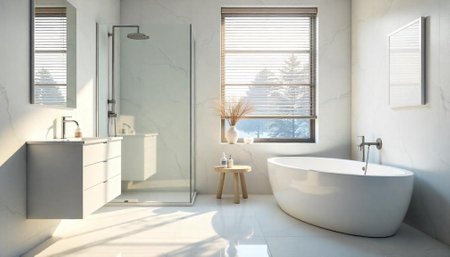Understanding British Bathroom Culture
When considering whether to install a shower or bath in your UK home, it’s important to first understand the unique bathroom culture found across Britain. Historically, baths have held a special place in British households, symbolising comfort, relaxation, and even a touch of luxury. In many traditional homes, the bath was a centrepiece—a place for unwinding after a long day and for family routines that spanned generations. However, as modern living has accelerated, showers have gained popularity due to their convenience and water efficiency. Today’s British bathrooms often reflect a blend of old and new, where practical needs meet enduring cultural habits. Your choice between a shower or bath isn’t just about plumbing; it’s shaped by lifestyle preferences, space constraints typical of UK properties, and even regional differences in how people prefer to bathe. Understanding these cultural nuances will help you make an informed decision that suits both your daily routine and your home’s character.
2. Space and Layout Considerations
When deciding between a shower or bath for your UK home, the size and layout of your bathroom play a pivotal role. Many British homes, especially period properties and city flats, are known for their compact bathrooms. This makes efficient use of available space essential when planning renovations or upgrades. Assessing your current bathroom dimensions is the first step towards making an informed decision.
Typical UK Bathroom Sizes
| Type of Property | Average Bathroom Size (sqm) |
|---|---|
| Victorian/Edwardian Terraced Houses | 2–4 |
| Modern Flats | 2–5 |
| Semi-Detached/Detached Houses | 3–6+ |
Shower vs Bath: Space Requirements
| Fixture | Minimum Recommended Space (cm) |
|---|---|
| Standard Shower Enclosure | 80 x 80 |
| Walk-in Shower | 90 x 120 |
| Standard Bath | 70 x 170 |
Maximising Your Layout
If your bathroom is on the smaller side—a common scenario in older UK properties—a shower may be the more practical option, as it conserves valuable floor space and allows for easier movement. Showers can also be tucked into corners or alcoves, maximising utility. On the other hand, if you have a larger bathroom or are keen on maintaining a traditional aesthetic, a bath can become a statement piece while still leaving room for storage and other fixtures. Consideration should also be given to door swings, radiator placements, and window locations when planning your ideal setup.
![]()
3. Water Efficiency and Environmental Impact
When deciding between a shower or a bath for your UK home, it’s essential to consider water efficiency and the broader environmental impact. The UK government has set ambitious sustainability goals, aiming to reduce water consumption and lower carbon emissions across households nationwide. With this in mind, let’s compare how showers and baths stack up against each other in terms of water usage and their effect on the environment.
Water Usage: Showers vs Baths
The average bath typically requires between 80 to 100 litres of water per use, while a standard shower, depending on the showerhead type and duration, uses roughly 35 to 50 litres in five minutes. Modern eco-showers can reduce this figure even further, making them an appealing choice for environmentally conscious homeowners. However, power showers or longer shower times may negate these savings, so it’s vital to keep usage habits in check.
Environmental Effects
Reducing water usage directly impacts the environment by conserving precious resources and lowering the energy needed to heat the water. In the UK, where much of our domestic hot water is heated via gas boilers or electric immersion heaters, shorter, efficient showers not only save water but also cut down on household energy bills and carbon emissions.
Supporting the UK’s Sustainability Goals
Opting for a quick shower over a deep bath aligns with national efforts to promote sustainability. Installing low-flow showerheads or considering timer devices can further enhance your homes efficiency. For those who prefer baths, using less water or sharing bathwater among family members (a common practice during droughts) can make a meaningful difference. Ultimately, being mindful of your daily routines helps support both your wallet and the UKs broader environmental objectives.
4. Cost and Installation Practicalities
When choosing between a shower and a bath for your UK home, understanding the costs involved is crucial. Both installation and ongoing maintenance expenses can vary considerably depending on your choice, and each option can have different implications for your propertys value.
Installation Costs
In the UK, showers typically cost less to install compared to baths, especially if you opt for a straightforward electric or mixer shower over an existing bath. However, if you’re considering a walk-in or digital shower, prices can rise significantly. Baths, particularly freestanding or whirlpool models, often require more extensive plumbing work and may need floor reinforcement in older properties.
| Feature | Shower (Average Cost) | Bath (Average Cost) |
|---|---|---|
| Standard Installation | £300–£600 | £400–£800 |
| Upgraded/Custom Installation | £700–£1,200+ | £900–£2,000+ |
| Labour Time | 1–2 days | 2–4 days |
Maintenance and Running Costs
Showers generally use less water than baths, which translates to lower utility bills—a key consideration with rising energy costs across the UK. Maintenance-wise, both require regular cleaning to prevent limescale build-up due to hard water common in many regions. Showers may need periodic replacement of seals and heads, while baths might require attention to the sealant around edges and waste outlets.
| Shower | Bath | |
|---|---|---|
| Average Water Use per Session* | 30–50 litres | 80–120 litres |
| Main Maintenance Needs | Limescale removal, seal checks, head replacement | Sealant renewal, waste outlet maintenance |
| Typical Annual Maintenance Cost** | £30–£60 | £40–£80 |
*Based on 5-minute shower and average full bath.
**Excludes major repairs or replacements.
Impact on Home Value
The right bathroom setup can positively influence your property’s market appeal. In urban areas like London or Manchester where space is at a premium, a modern shower room is often highly valued by buyers and renters. However, family homes in suburban or rural settings might benefit from having at least one bath for practicality with children. Ultimately, the decision should balance your immediate needs with potential future resale benefits.
5. Personal Comfort and Accessibility
When deciding between a shower or bath for your UK home, it’s crucial to consider the comfort and accessibility needs of everyone in your household. Families with young children may find a bath more practical, as it provides a safe and enjoyable environment for bathing little ones. Parents can more easily supervise toddlers and ensure they’re thoroughly clean, which is often more challenging in a standing shower.
For older adults or those with limited mobility, showers—especially walk-in varieties—offer greater ease of use. Many British homes are now being retrofitted with accessible shower options, such as low thresholds, grab rails, and anti-slip trays. These features make daily routines safer and help individuals maintain independence for longer. In contrast, climbing in and out of a traditional bath can pose safety risks for elderly family members.
It’s also worth thinking about how personal preferences shape comfort. Some people cherish a long soak after a chilly day, while others prefer the invigorating rush of a morning shower before heading out into the unpredictable British weather. The layout of typical UK bathrooms, which are often compact, can influence what’s most feasible without compromising on convenience.
Ultimately, choosing the right solution means balancing individual needs with practical limitations. Whether you opt for a full-size tub, a spacious walk-in shower, or even a combination unit, ensure that your bathroom supports the wellbeing of everyone at home—today and as your household’s needs evolve over time.
6. Resale Value and Home Appeal
When considering whether to install a shower, bath, or both in your UK home, it’s essential to think beyond personal preferences and look at how these choices impact your propertys resale value and appeal. In the British property market, bathrooms play a significant role in influencing buyers’ decisions. Many house hunters expect at least one traditional bathtub, particularly in family homes where young children are a consideration. A bath can be seen as a must-have for families and adds to the classic charm that many buyers seek.
On the other hand, modern showers are highly attractive to professionals and couples who value convenience and efficiency. In urban areas or smaller properties, a stylish walk-in shower can actually boost your homes appeal by maximising space and giving an up-to-date feel. However, completely removing all baths from your property could narrow your pool of potential buyers, especially if you’re selling a three-bedroom house or larger.
For those looking to sell in the near future, striking a balance is often the best route—consider retaining at least one bath if space allows, while ensuring there is also a high-quality shower. This dual approach appeals to the broadest range of buyers, from busy city dwellers to growing families. Ultimately, the right choice for your bathroom not only enhances your daily comfort but can also make a tangible difference when it comes time to put your UK home on the market.
7. Making the Right Choice for Your Lifestyle
Choosing between a shower or bath for your UK home ultimately comes down to a balance of practicality, budget, and personal preference. Consider the size and layout of your bathroom, as well as your household’s daily routines. Showers are ideal for those with busy lifestyles seeking efficiency and water savings, while baths offer a touch of luxury and relaxation—perfect after a long day or for families with young children. Think about ongoing maintenance: showers generally require less cleaning and upkeep compared to baths, especially in hard water areas common across the UK. Additionally, weigh up energy and water usage costs, which can impact your utility bills over time. Finally, if you’re planning future renovations or selling your home, remember that both options can add value, but versatility often appeals to prospective buyers. By reflecting on these key points, UK homeowners can make an informed and practical decision that suits both their current needs and long-term plans.

